Emergency Monitoring of a Tailings Pond Leakage Accident Based on the GEE Platform
Abstract
:1. Introduction
2. Materials and Methods
2.1. Study Area
2.2. Datasets
2.3. Method
2.3.1. GEE-Based Pollution Dynamic Monitoring
2.3.2. GEE-Based Time Series Index Computing
3. Results
3.1. Results of GEE Pollution Dynamic Monitoring
3.2. Time Series NDVI Calculation Results
3.3. Time Series NDTI Calculation Results
4. Discussion
5. Conclusions
- (1)
- Through spectral changes in monitoring points in the downstream rivers of the tailings pond, it was found that: the spectra of rivers polluted by tailings sand are obviously different from those of unpolluted rivers, which are mainly manifested in the obvious increase in spectral reflectance in the blue, green or red band. Just after the accident, the spectral reflectance of the upstream monitoring points was the highest. With the passage of time, the spectral reflectance of the downstream monitoring points increased, and finally all returned to normal.
- (2)
- The pollution caused by the dam break of the tailings pond was quickly treated in a short time, and the river spectrum returned to normal on April 13. The pollution spread for approximately 300 km downstream of the Yijimi River and the Hulan River, and was finally intercepted at the Lanxi Old Bridge 67 km away from the Songhua River, so that more serious pollution accidents were avoided. This accident had a direct impact on the surrounding six counties, and after the accident was handled, the impact gradually disappeared.
- (3)
- The dam break of the tailings pond had a certain degree of impact on the surrounding vegetation, resulting in a small decrease in NDVI, and after the dam break accident, the water content of the tailings ponds decreased, indicating that remedial measures such as pumping water were taken after the accident, and production was paused for a certain period of time after the accident.
Author Contributions
Funding
Data Availability Statement
Conflicts of Interest
References
- Zhang, J.; Liu, J. The statistics and causes of dam break and leakage in chinese tailings pond. China Molybdenum Ind. 2019, 43, 10–14. [Google Scholar] [CrossRef]
- HJ 740-2015; Technical Guidelines for Environmental Risk Assessment of Tailings Ponds (Trial). Ministry of Environment Protection: Beijing, China, 2015.
- Wo, T.S. Tailings Pond Handbook; Metallurgical Industry Press: Beijing, China, 2013. [Google Scholar]
- Ding, L.; Fang, X.; Cheng, S.; Zeng, K.; Liu, C. Study of Tailings Ponds’ Environmental Impact Region in Chengui Town, Daye based on Watershed Analysis. In Advanced Materials Research, Proceedings of the 3rd International Conference on Energy, Environment and Sustainable Development (EESD 2013), Shanghai, China, 12–13 November 2013; Trans Tech Publications Ltd.: Freienbach, Switzerland, 2014; pp. 2772–2776. [Google Scholar]
- Wang, Y.B.; Xue, L.Y.; Liu, J.; Wang, J.X. Measures and application of environmental emergency treatment for sudden water polution incidents in tailing pond. Environ. Pollut. Prev. 2022, 44, 541–545. [Google Scholar] [CrossRef]
- Jha, A.; Tukkaraja, P. Monitoring and assessment of underground climatic conditions using sensors and GIS tools. Int. J. Min. Sci. Technol. 2020, 30, 495–499. [Google Scholar] [CrossRef]
- Xiao, R.; Shen, W.; Fu, Z.; Shi, Y.; Xiong, W.; Cao, F. The application of remote sensing in the environmental risk monitoring of tailings pond—A case study in Zhangjiakou area of China. In Proceedings of the Conference on Earth Resources and Environmental Remote Sensing/GIS Applications III, Edinburgh, UK, 24–26 September 2012. [Google Scholar]
- Zhang, C.; Xing, J.; Li, J.; Sang, X. Spatial range recognition of tailings Pond based on U-NET network and GF-6 image. Remote Sens. Nat. Resour. 2021, 33, 252–257. [Google Scholar] [CrossRef]
- Song, S.; Chu, J.; Zhang, H. Study on Environmental Risk Assessment and Control Countermeasures of Tailings pond in a Mountainous Area of North China. In Proceedings of the 6th International Conference on Energy, Environment and Materials Science (EEMS), Hulun Buir, China, 28–30 August 2020. [Google Scholar]
- Zhao, H.; Zhao, X.; Zhang, L.; Jia, L.; Jiang, J.; Wang, L.; Yin, Z.; Zhu, X. A mineral feature extraction method based on virtual band simulation. Remote Sens. Lett. 2017, 8, 547–556. [Google Scholar] [CrossRef]
- Huang, H.B.; Chen, Y.L.; Clinton, N.; Wang, J.; Wang, X.Y.; Liu, C.X.; Gong, P.; Yang, J.; Bai, Y.Q.; Zheng, Y.M.; et al. Mapping major land cover dynamics in Beijing using all Landsat images in Google Earth Engine. Remote Sens. Environ. 2017, 202, 166–176. [Google Scholar] [CrossRef]
- Lobell, D.; Thau, D.; Seifert, C.; Engle, E.; Littl, B. A scalable satellite-based crop yield mapper. Remote Sens. Environ. 2015, 164, 324–333. [Google Scholar] [CrossRef]
- Hao., B.; Han, X.; Ma, M.; Liu, Y.; Li, S. Application of Google Earth engine in Earth Science and Environmental Science. Remote Sens. Technol. Appl. 2018, 33, 600–611. [Google Scholar] [CrossRef]
- He, T.; Xiao, W.; Zhao, Y.L.; Deng, X.; Hu, Z. Identification of waterlogging in Eastern China induced by mining subsidence: A case study of Google Earth Engine time-series analysis applied to the Huainan coal field. Remote Sens. Environ. 2020, 242, 111742. [Google Scholar] [CrossRef]
- Sun, G.; Chen, F.; Wang, N. Landslide change and its influence factors in central Nepal from 2001 to 2017. J. Univ. Chin. Acad. Sci. 2020, 37, 308–316. [Google Scholar] [CrossRef]
- Ma, H.; Zhang, Y.; Li, J. Analysis on research status about physical model tests of tailings pond in China. J. Saf. Sci. Technol. 2020, 16, 61–66. [Google Scholar] [CrossRef]
- Jensen, J.R. Remote Sensing of the Environment: An Earth Resource Perspective, 2nd ed.; Pearson Prentice Hall: Hoboken, NJ, USA, 2007. [Google Scholar]
- Wang, C.-J.; Zhou, B.; Zheng, Y.-Y.; Yu, Z.-F. Navigation Observation of Reflectance Spectrum of Water Surface in Inland Rivers. Spectrosc. Spect. Anal. 2022, 42, 878–883. [Google Scholar] [CrossRef]
- Huang, S.; Tang, L.; Hupy, J.P.; Wang, Y.; Shao, G. Commentary review on the use of normalized difference vegetation index (NDVI) in the era of popular remote sensing. J. For. Res. 2021, 32, 2719. [Google Scholar] [CrossRef]
- Yu, M.L.; Liu, S.J.; Song, L.; Huang, J.W.; Li, T.Z.; Wang, D. Spectral Characteristics and Remote Sensing Model of Tailings with Different Water Contents. Spectrosc. Spect. Anal. 2019, 39, 3096–3101. [Google Scholar] [CrossRef]
- Chen, S.; Chang, S.; Huang, D. Development and application of emergency treatment process for polluted river water caused by leakage of tailing pond of Luming mining in Heilongjiang Province on March 28. Chin. J. Environ. Eng. 2021, 15, 2895–2903. [Google Scholar]
- Kossoff, D.; Dubbin, W.E.; Alfredsson, M.; Edwards, S.J.; Macklin, M.G.; Hudson-Edwards, K.A. Mine tailings dams: Characteristics, failure, environmental impacts, and remediation. Appl. Geochem. 2014, 51, 229–245. [Google Scholar] [CrossRef] [Green Version]
- Penman, A. Tailings Dams: Risk of Dangerous Occurrences. In Geoenvironmental Engineering: Geoenvironmental Impact Management: Proceedings of the Third Conference Organized by the British Geotechnical Association and Cardiff School of Engineering, Cardiff University, Edinburgh, UK, 17–19 September 2001; Thomas Telford Publishing: London, UK, 2001. [Google Scholar]
- Wang, X.; Tian, J.; Li, X.; Wang, L.; Gong, H.; Chen, B.; Li, X.; Guo, J. Benefits of Google Earth Engine in remote sensing. J. Remote Sens. 2022, 26, 299–309. [Google Scholar]
- Wang, L.; Xu, M.; Liu, Y.; Liu, H.; Beck, R.; Reif, M.; Emery, E.; Young, J.; Wu, Q. Mapping Freshwater Chlorophyll-a Concentrations at a Regional Scale Integrating Multi-Sensor Satellite Observations with Google Earth Engine. Remote Sens. 2020, 12, 3278. [Google Scholar] [CrossRef]
- Gorelick, N.; Hancher, M.; Dixon, M.; Ilyushchenko, S.; Thau, D.; Moore, R. Google Earth Engine: Planetary-scale geospatial analysis for everyone. Remote Sens. Environ. 2017, 202, 18–27. [Google Scholar] [CrossRef]
- Cheng, W.; Qian, X.; Li, S.; Ma, H.; Liu, D.; Liu, F.; Liang, J.; Ju, H. Research and application of PIE-Engine Studio for spatiotemporal remote sensing cloud computing platform. J. Remote Sens. 2022, 26, 347–355. [Google Scholar]

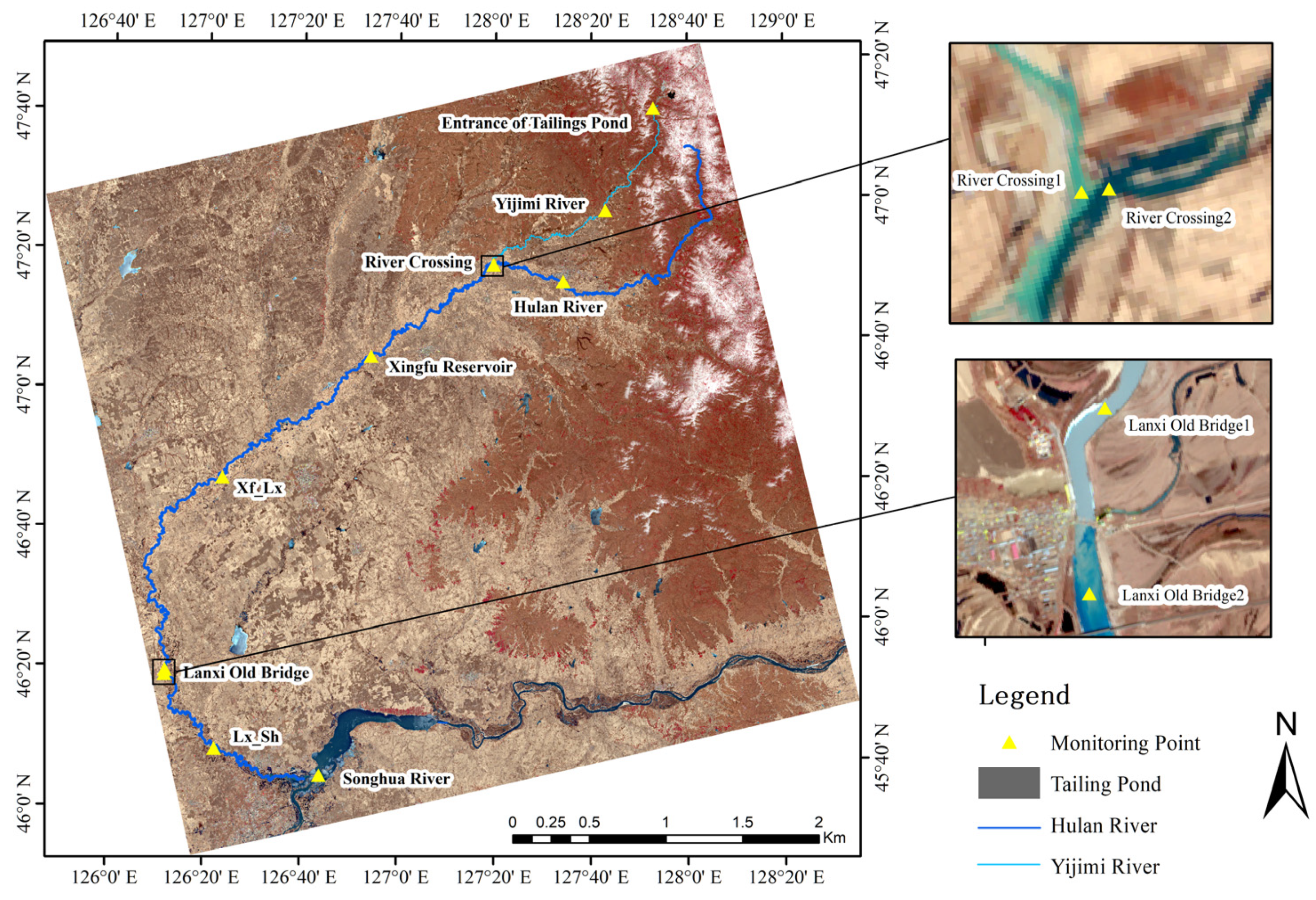
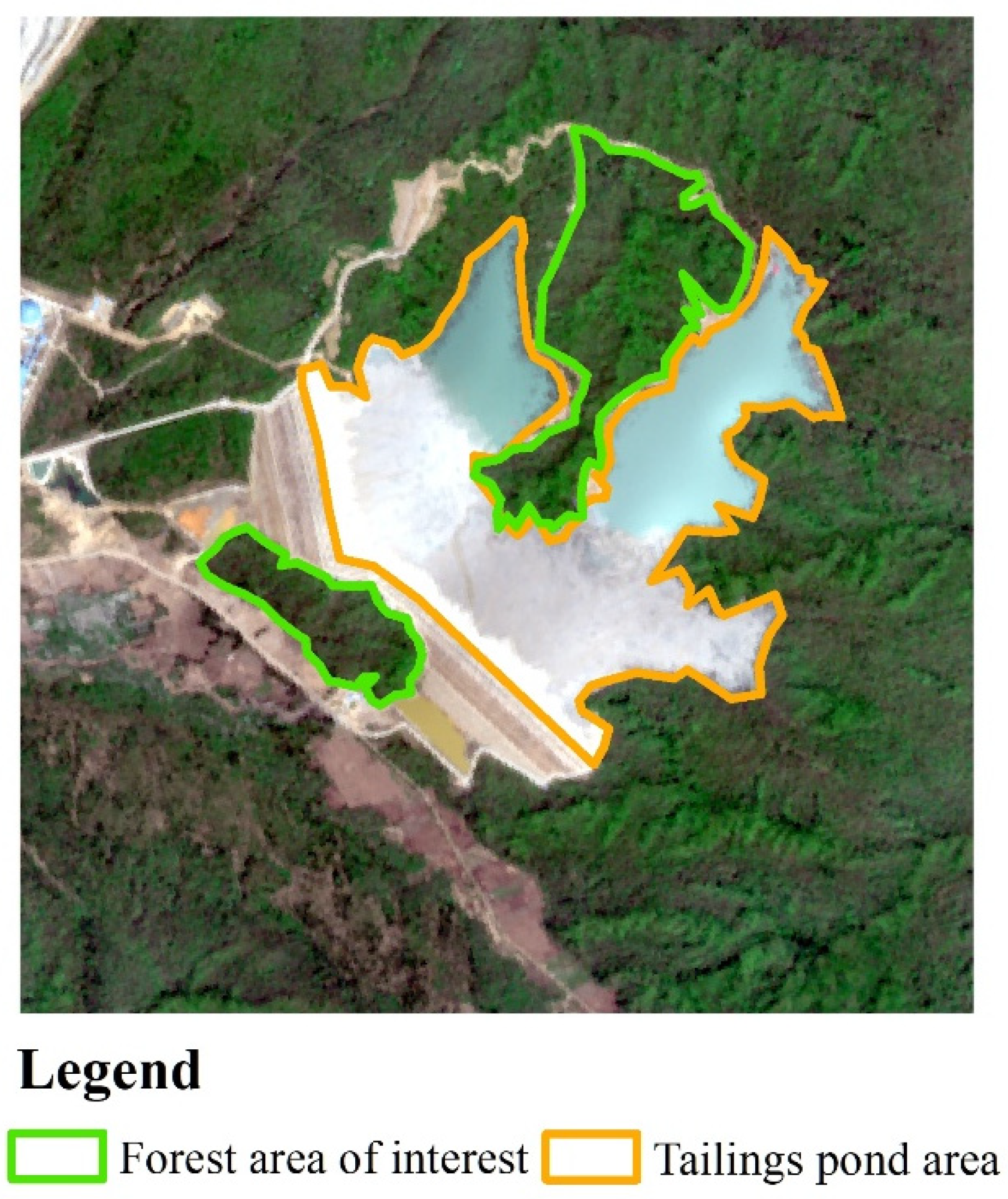
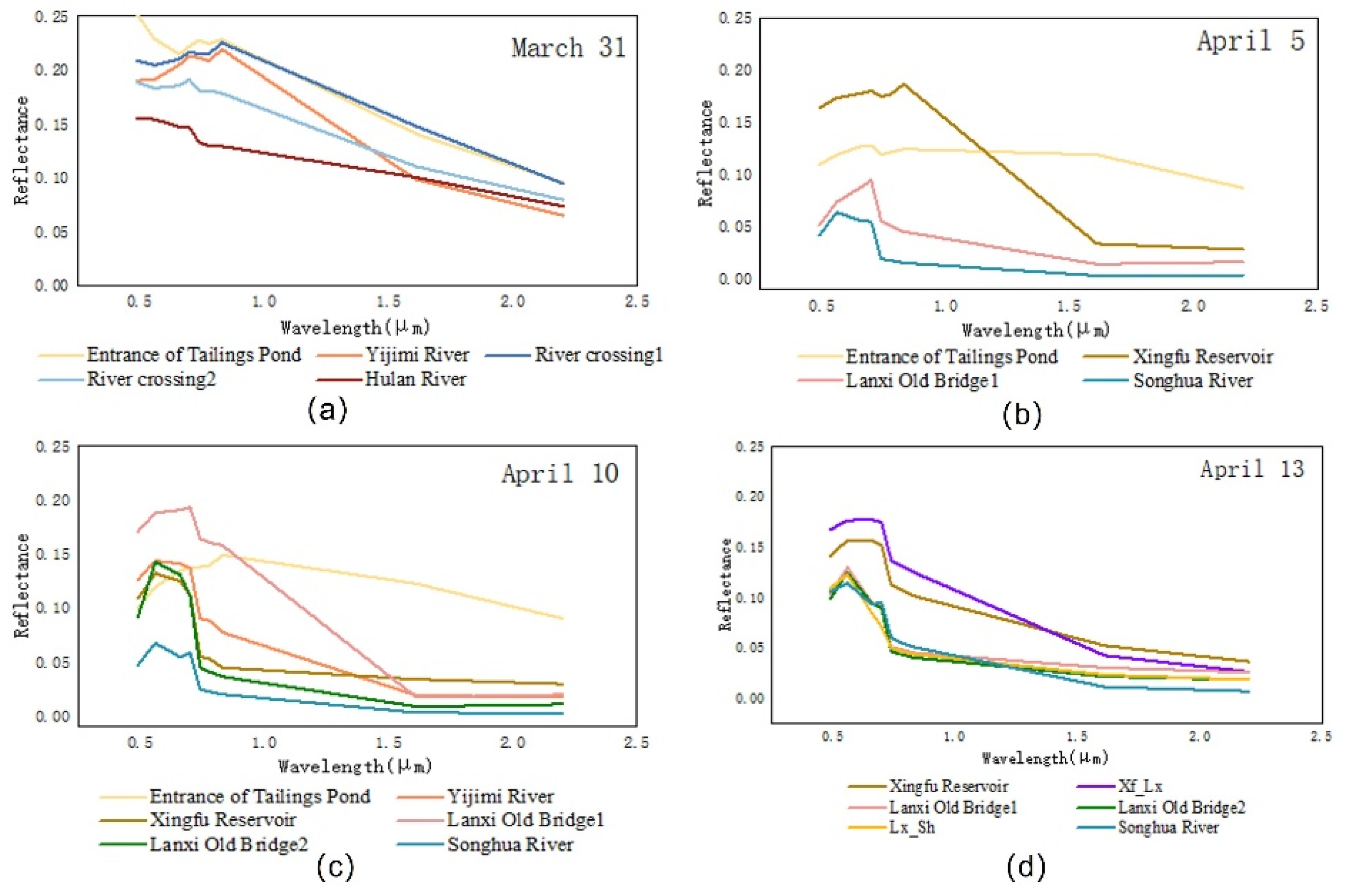

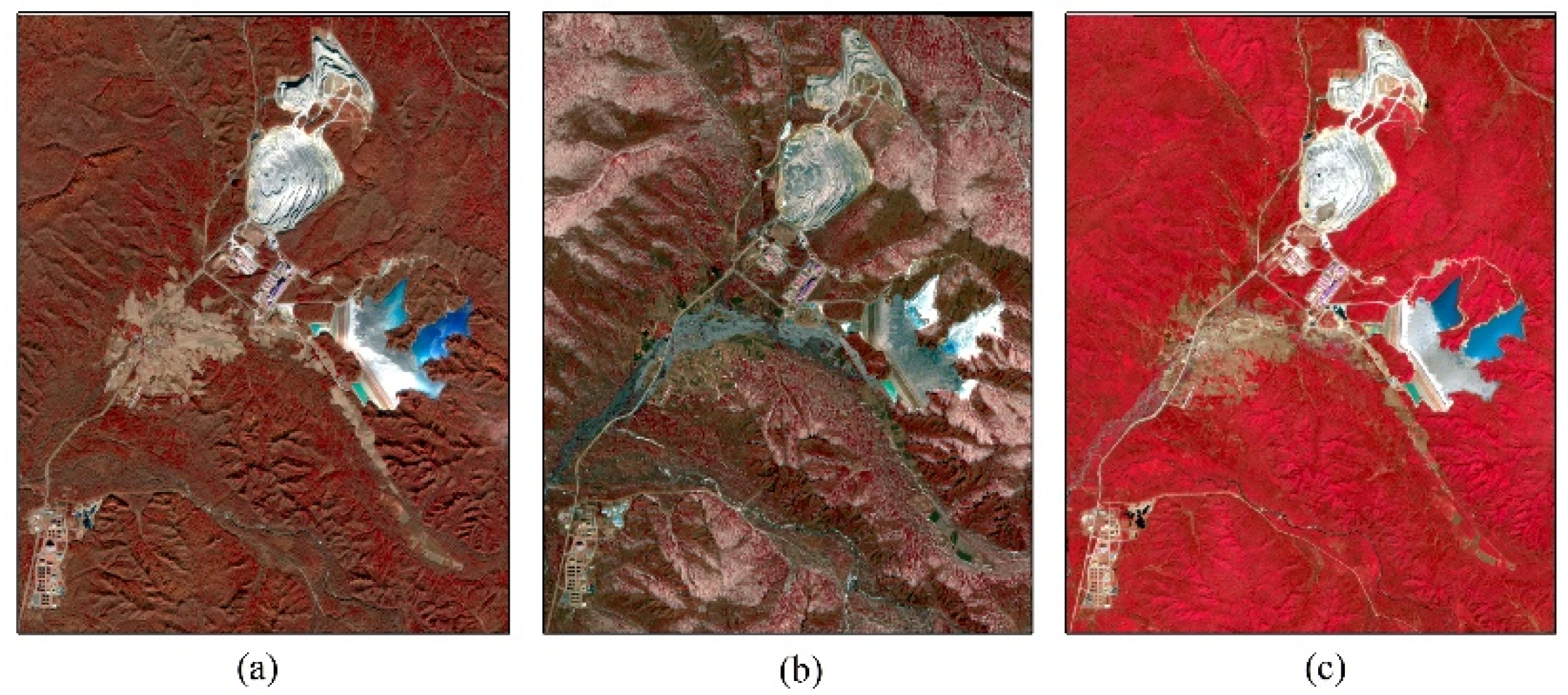

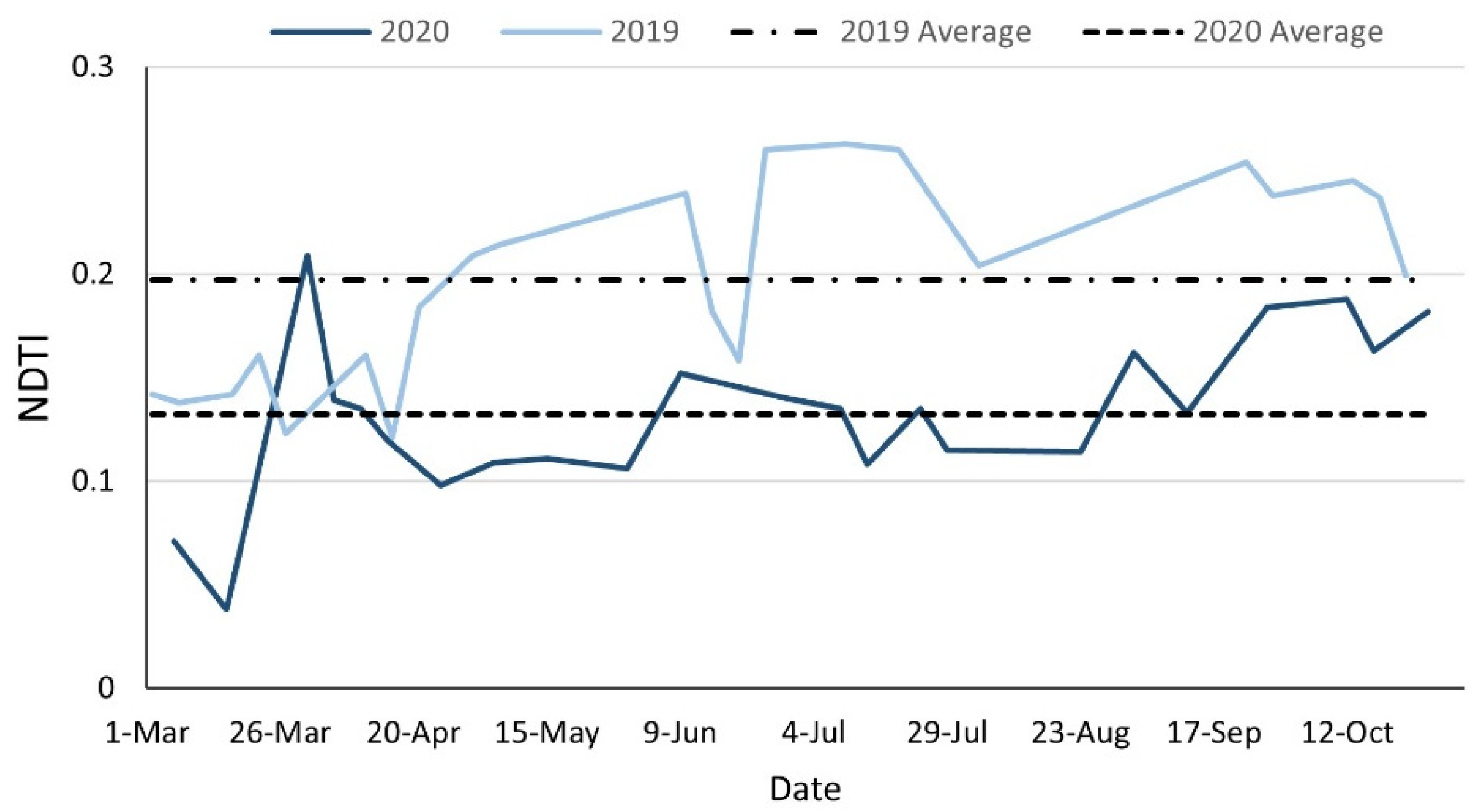
| Name | Description | Resolution | Wavelength |
|---|---|---|---|
| B1 | Aerosols | 60 m | 443.9 nm (S2A)/442.3 nm (S2B) |
| B2 | Blue | 10 m | 496.6 nm (S2A)/492.1 nm (S2B) |
| B3 | Green | 10 m | 560 nm (S2A)/559 nm (S2B) |
| B4 | Red | 10 m | 664.5 nm (S2A)/665 nm (S2B) |
| B5 | Red Edge1 | 20 m | 703.9 nm (S2A)/703.8 nm (S2B) |
| B6 | Red Edge2 | 20 m | 740.2 nm (S2A)/739.1 nm (S2B) |
| B7 | Red Edge3 | 20 m | 782.5 nm (S2A)/779.7 nm (S2B) |
| B8 | NIR | 10 m | 835.1 nm (S2A)/833 nm (S2B) |
| B8A | Red Edge4 | 20 m | 864.8 nm (S2A)/864 nm (S2B) |
| B9 | Water Vapor | 60 m | 945 nm (S2A)/943.2 nm (S2B) |
| B10 | Cirrus | 60 m | 1373.5 nm (S2A)/1376.9 nm (S2B) |
| B11 | SWIR 1 | 20 m | 1613.7 nm (S2A)/1610.4 nm (S2B) |
| B12 | SWIR 2 | 20 m | 2202.4 nm (S2A)/2185.7 nm (S2B) |
Publisher’s Note: MDPI stays neutral with regard to jurisdictional claims in published maps and institutional affiliations. |
© 2022 by the authors. Licensee MDPI, Basel, Switzerland. This article is an open access article distributed under the terms and conditions of the Creative Commons Attribution (CC BY) license (https://creativecommons.org/licenses/by/4.0/).
Share and Cite
Zhao, H.; Yang, Z.; Zhang, H.; Meng, J.; Jin, Q.; Ming, S. Emergency Monitoring of a Tailings Pond Leakage Accident Based on the GEE Platform. Sustainability 2022, 14, 8558. https://doi.org/10.3390/su14148558
Zhao H, Yang Z, Zhang H, Meng J, Jin Q, Ming S. Emergency Monitoring of a Tailings Pond Leakage Accident Based on the GEE Platform. Sustainability. 2022; 14(14):8558. https://doi.org/10.3390/su14148558
Chicago/Turabian StyleZhao, Hengqian, Zihan Yang, Hongwei Zhang, Jianwei Meng, Qian Jin, and Shikang Ming. 2022. "Emergency Monitoring of a Tailings Pond Leakage Accident Based on the GEE Platform" Sustainability 14, no. 14: 8558. https://doi.org/10.3390/su14148558
APA StyleZhao, H., Yang, Z., Zhang, H., Meng, J., Jin, Q., & Ming, S. (2022). Emergency Monitoring of a Tailings Pond Leakage Accident Based on the GEE Platform. Sustainability, 14(14), 8558. https://doi.org/10.3390/su14148558






